University Policy Evaluation: NCLB Act and ESSA Comparison Proposal
VerifiedAdded on 2021/12/10
|19
|4464
|165
Essay
AI Summary
This essay presents an evaluation proposal focusing on the No Child Left Behind Act (NCLB). It begins with an introduction and a summary of the NCLB Act, highlighting its goals of improving education for disadvantaged students and ensuring qualified teachers. The thesis statement argues that despite its positive intentions, the NCLB Act had significant drawbacks, particularly in its accountability-focused approach, which proved more punitive than constructive, and failed to address student development comprehensively. The paper then explores the desired outcome, importance of the outcome, and research questions. A literature review discusses tools to evaluate the NCLB Act, such as performance measurement, utility, feasibility, propriety, and accuracy. The essay identifies drawbacks like poor performance, lack of utility, and issues with feasibility and accuracy. The analysis concludes by emphasizing the need for the Every Student Succeeds Act (ESSA) to replace NCLB. The paper offers solutions, suggesting a more holistic approach to student learning that considers both strengths and weaknesses, and proposes a more comprehensive evaluation of educators. The methodology involves analyzing scholarly articles, journals, statistics, and books to support the arguments.

Running head: EVALUATION PROPOSAL OF A PUBLIC POLICY
Evaluation Proposal of a Public Policy
Name of the Student
Name of the University
Author Note
Evaluation Proposal of a Public Policy
Name of the Student
Name of the University
Author Note
Paraphrase This Document
Need a fresh take? Get an instant paraphrase of this document with our AI Paraphraser
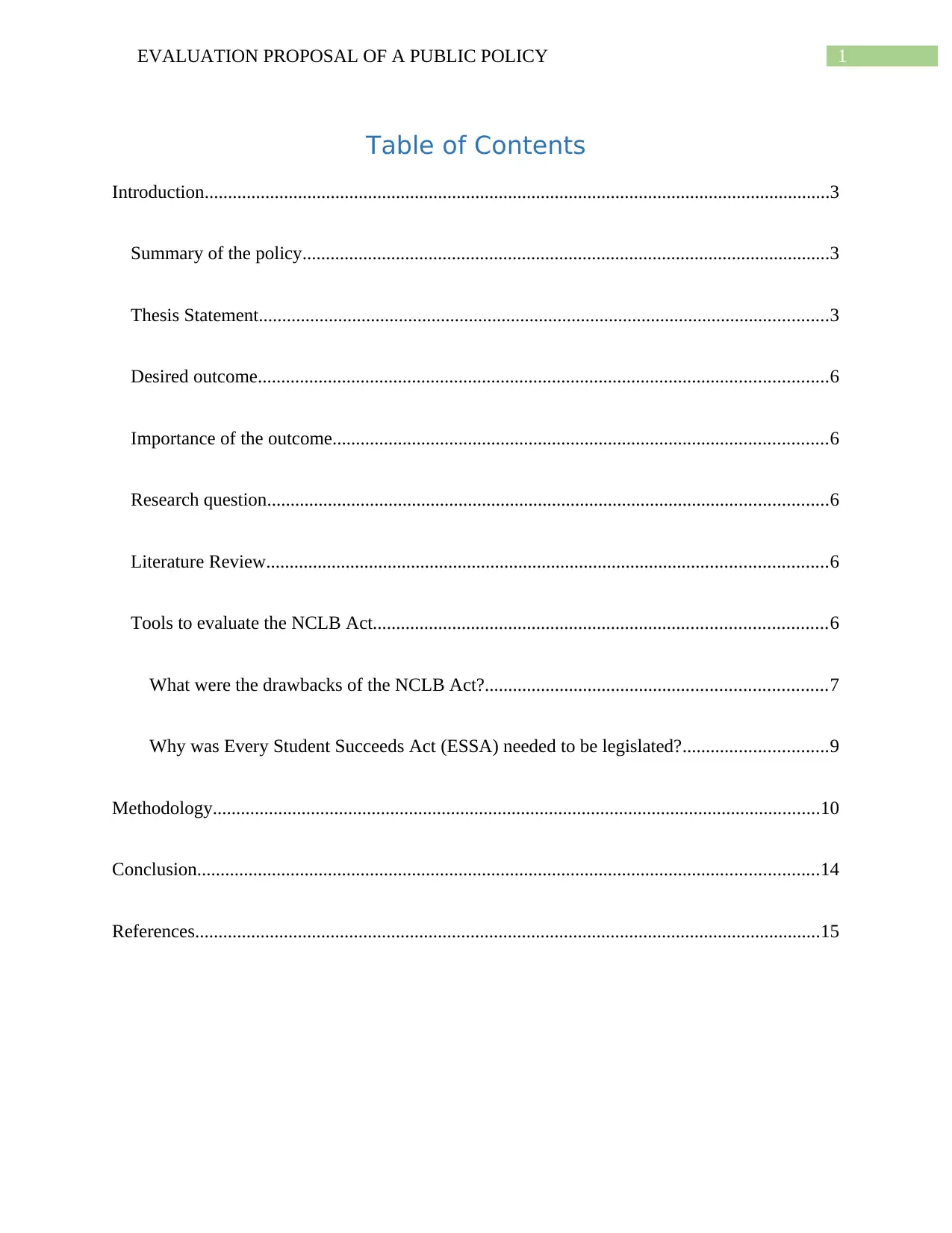
1EVALUATION PROPOSAL OF A PUBLIC POLICY
Table of Contents
Introduction......................................................................................................................................3
Summary of the policy.................................................................................................................3
Thesis Statement..........................................................................................................................3
Desired outcome..........................................................................................................................6
Importance of the outcome..........................................................................................................6
Research question........................................................................................................................6
Literature Review........................................................................................................................6
Tools to evaluate the NCLB Act.................................................................................................6
What were the drawbacks of the NCLB Act?.........................................................................7
Why was Every Student Succeeds Act (ESSA) needed to be legislated?...............................9
Methodology..................................................................................................................................10
Conclusion.....................................................................................................................................14
References......................................................................................................................................15
Table of Contents
Introduction......................................................................................................................................3
Summary of the policy.................................................................................................................3
Thesis Statement..........................................................................................................................3
Desired outcome..........................................................................................................................6
Importance of the outcome..........................................................................................................6
Research question........................................................................................................................6
Literature Review........................................................................................................................6
Tools to evaluate the NCLB Act.................................................................................................6
What were the drawbacks of the NCLB Act?.........................................................................7
Why was Every Student Succeeds Act (ESSA) needed to be legislated?...............................9
Methodology..................................................................................................................................10
Conclusion.....................................................................................................................................14
References......................................................................................................................................15
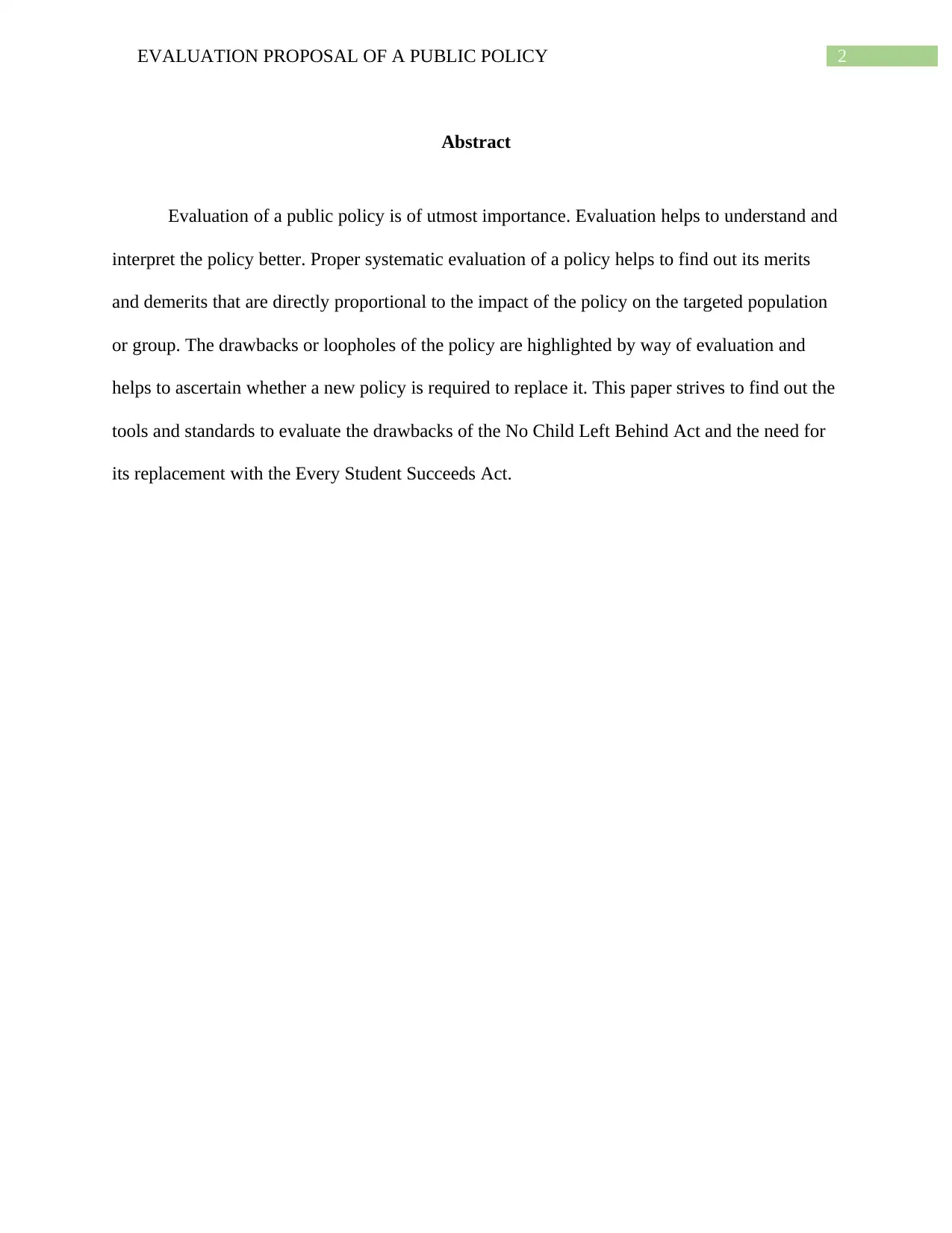
2EVALUATION PROPOSAL OF A PUBLIC POLICY
Abstract
Evaluation of a public policy is of utmost importance. Evaluation helps to understand and
interpret the policy better. Proper systematic evaluation of a policy helps to find out its merits
and demerits that are directly proportional to the impact of the policy on the targeted population
or group. The drawbacks or loopholes of the policy are highlighted by way of evaluation and
helps to ascertain whether a new policy is required to replace it. This paper strives to find out the
tools and standards to evaluate the drawbacks of the No Child Left Behind Act and the need for
its replacement with the Every Student Succeeds Act.
Abstract
Evaluation of a public policy is of utmost importance. Evaluation helps to understand and
interpret the policy better. Proper systematic evaluation of a policy helps to find out its merits
and demerits that are directly proportional to the impact of the policy on the targeted population
or group. The drawbacks or loopholes of the policy are highlighted by way of evaluation and
helps to ascertain whether a new policy is required to replace it. This paper strives to find out the
tools and standards to evaluate the drawbacks of the No Child Left Behind Act and the need for
its replacement with the Every Student Succeeds Act.
⊘ This is a preview!⊘
Do you want full access?
Subscribe today to unlock all pages.

Trusted by 1+ million students worldwide

3EVALUATION PROPOSAL OF A PUBLIC POLICY
EVALUATION OF THE NO CHILD LEFT BEHIND ACT
Introduction
Summary of the policy
No Child Left Behind Act 2001 (NCLB Act) was a legislation of the US Congress which
was made to give effect to the Elementary and Secondary Education Act (Www2.ed.gov. 2018).
This Act grew out of the notion that the American education system was not competitive enough
in accordance to international standard. The Act focused on boosting the education for students
in special education, poor and minority children, and the new English learning students. The Act
made sure that the schools employ trained and qualified teachers and gave a strategic plan to hire
them (Elpus, 2014).
Thesis Statement
No Child Left Behind Act 2001 (NCLB Act) was an Act of the United States Congress to
reauthorize the Elementary and Secondary Education Act. The Act expanded the scope of law
providing that the states should introduce a system for school-accountability to be applied to the
students and public schools of the state (Www2.ed.gov. 2018). The civil rights advocates praised
the Act for its focus on improving the education for economically backward, disabled students
and new English learners in 2002. Additionally, the Act obliges the schools to employ qualified
and appropriate teachers and states to prepare a plan to hire the teachers. The schools were
required to take a step towards both setting and attaining proficiency goals by way of the
imposition of yearly progress checkpoints, as well as a system of organized consequences that
EVALUATION OF THE NO CHILD LEFT BEHIND ACT
Introduction
Summary of the policy
No Child Left Behind Act 2001 (NCLB Act) was a legislation of the US Congress which
was made to give effect to the Elementary and Secondary Education Act (Www2.ed.gov. 2018).
This Act grew out of the notion that the American education system was not competitive enough
in accordance to international standard. The Act focused on boosting the education for students
in special education, poor and minority children, and the new English learning students. The Act
made sure that the schools employ trained and qualified teachers and gave a strategic plan to hire
them (Elpus, 2014).
Thesis Statement
No Child Left Behind Act 2001 (NCLB Act) was an Act of the United States Congress to
reauthorize the Elementary and Secondary Education Act. The Act expanded the scope of law
providing that the states should introduce a system for school-accountability to be applied to the
students and public schools of the state (Www2.ed.gov. 2018). The civil rights advocates praised
the Act for its focus on improving the education for economically backward, disabled students
and new English learners in 2002. Additionally, the Act obliges the schools to employ qualified
and appropriate teachers and states to prepare a plan to hire the teachers. The schools were
required to take a step towards both setting and attaining proficiency goals by way of the
imposition of yearly progress checkpoints, as well as a system of organized consequences that
Paraphrase This Document
Need a fresh take? Get an instant paraphrase of this document with our AI Paraphraser
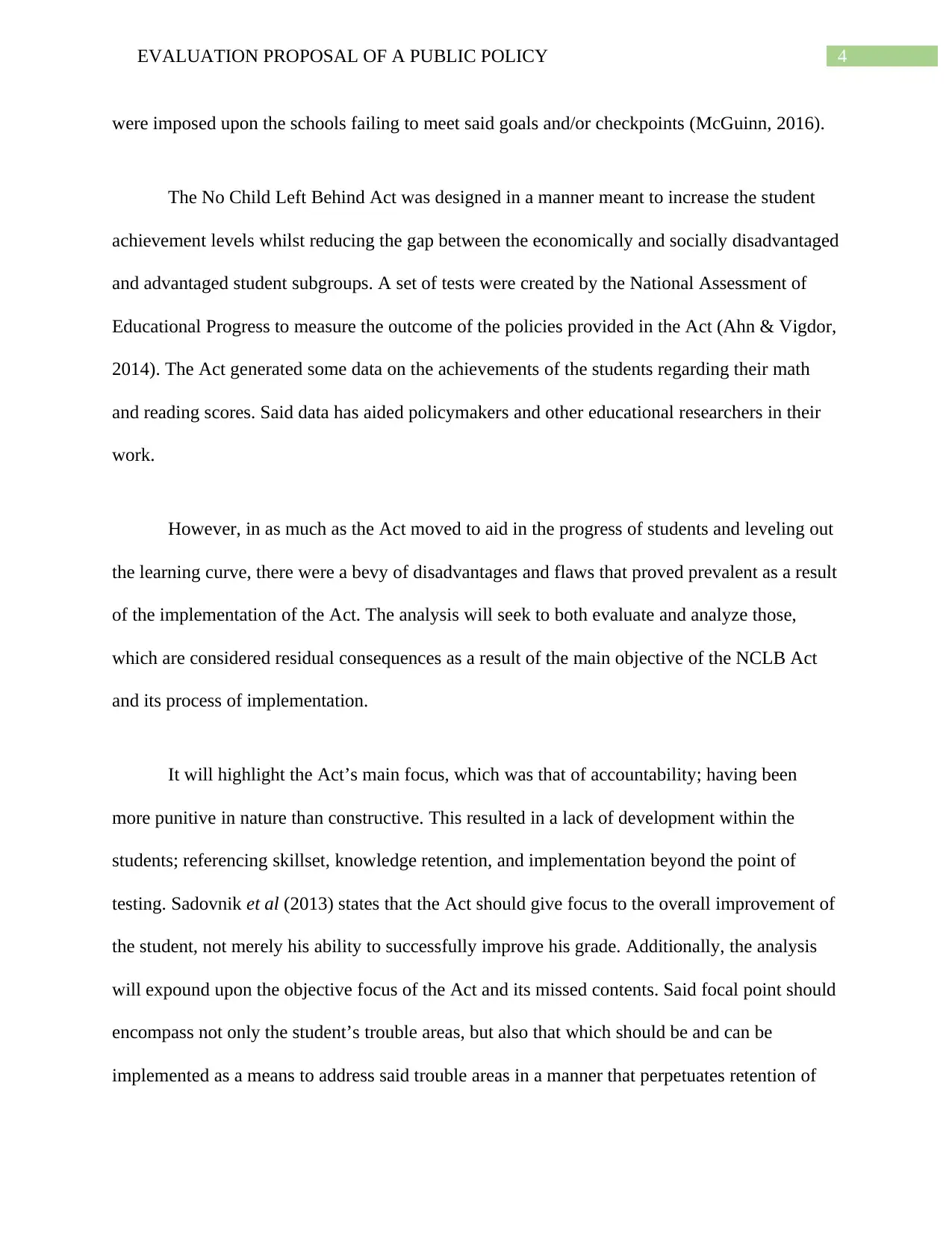
4EVALUATION PROPOSAL OF A PUBLIC POLICY
were imposed upon the schools failing to meet said goals and/or checkpoints (McGuinn, 2016).
The No Child Left Behind Act was designed in a manner meant to increase the student
achievement levels whilst reducing the gap between the economically and socially disadvantaged
and advantaged student subgroups. A set of tests were created by the National Assessment of
Educational Progress to measure the outcome of the policies provided in the Act (Ahn & Vigdor,
2014). The Act generated some data on the achievements of the students regarding their math
and reading scores. Said data has aided policymakers and other educational researchers in their
work.
However, in as much as the Act moved to aid in the progress of students and leveling out
the learning curve, there were a bevy of disadvantages and flaws that proved prevalent as a result
of the implementation of the Act. The analysis will seek to both evaluate and analyze those,
which are considered residual consequences as a result of the main objective of the NCLB Act
and its process of implementation.
It will highlight the Act’s main focus, which was that of accountability; having been
more punitive in nature than constructive. This resulted in a lack of development within the
students; referencing skillset, knowledge retention, and implementation beyond the point of
testing. Sadovnik et al (2013) states that the Act should give focus to the overall improvement of
the student, not merely his ability to successfully improve his grade. Additionally, the analysis
will expound upon the objective focus of the Act and its missed contents. Said focal point should
encompass not only the student’s trouble areas, but also that which should be and can be
implemented as a means to address said trouble areas in a manner that perpetuates retention of
were imposed upon the schools failing to meet said goals and/or checkpoints (McGuinn, 2016).
The No Child Left Behind Act was designed in a manner meant to increase the student
achievement levels whilst reducing the gap between the economically and socially disadvantaged
and advantaged student subgroups. A set of tests were created by the National Assessment of
Educational Progress to measure the outcome of the policies provided in the Act (Ahn & Vigdor,
2014). The Act generated some data on the achievements of the students regarding their math
and reading scores. Said data has aided policymakers and other educational researchers in their
work.
However, in as much as the Act moved to aid in the progress of students and leveling out
the learning curve, there were a bevy of disadvantages and flaws that proved prevalent as a result
of the implementation of the Act. The analysis will seek to both evaluate and analyze those,
which are considered residual consequences as a result of the main objective of the NCLB Act
and its process of implementation.
It will highlight the Act’s main focus, which was that of accountability; having been
more punitive in nature than constructive. This resulted in a lack of development within the
students; referencing skillset, knowledge retention, and implementation beyond the point of
testing. Sadovnik et al (2013) states that the Act should give focus to the overall improvement of
the student, not merely his ability to successfully improve his grade. Additionally, the analysis
will expound upon the objective focus of the Act and its missed contents. Said focal point should
encompass not only the student’s trouble areas, but also that which should be and can be
implemented as a means to address said trouble areas in a manner that perpetuates retention of
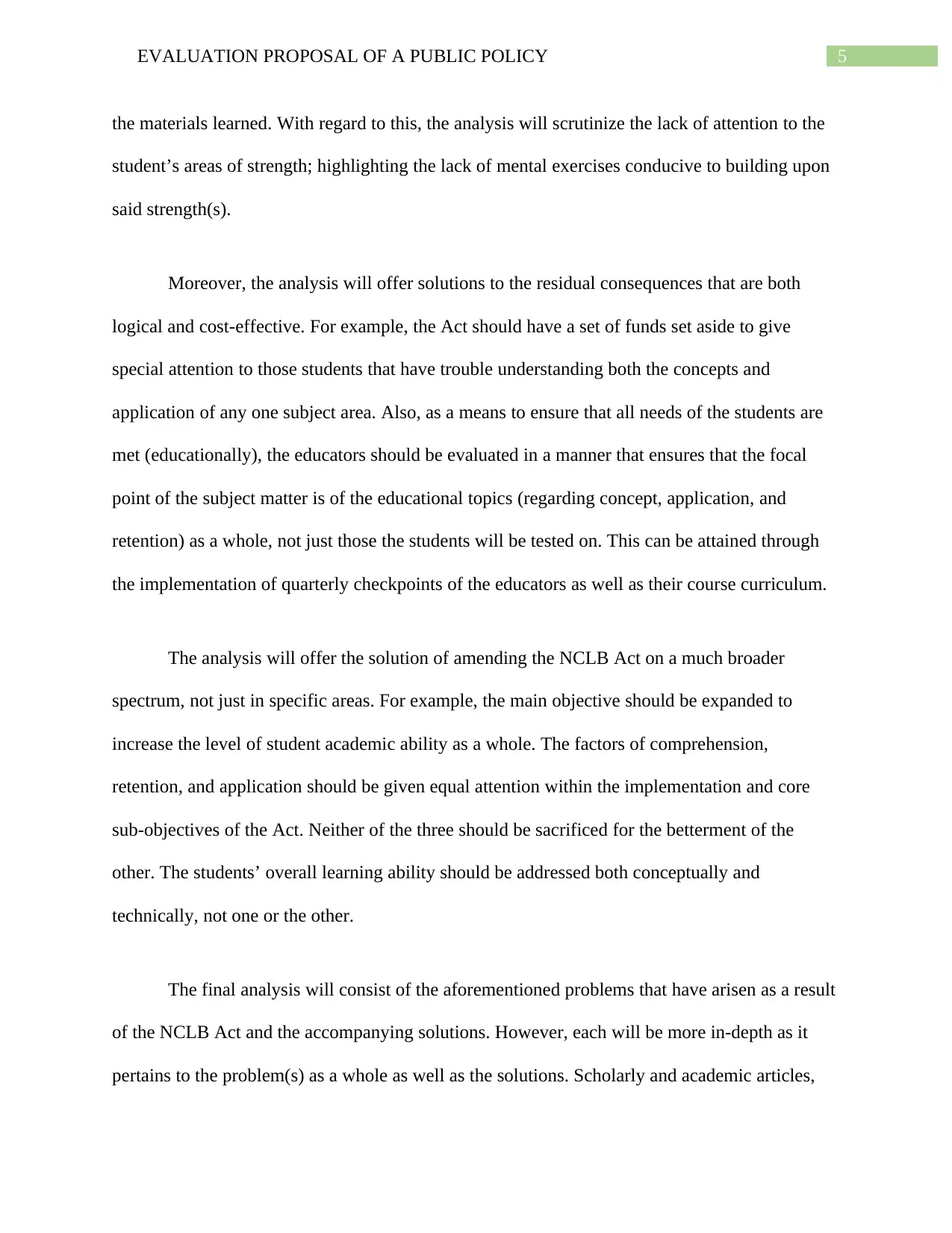
5EVALUATION PROPOSAL OF A PUBLIC POLICY
the materials learned. With regard to this, the analysis will scrutinize the lack of attention to the
student’s areas of strength; highlighting the lack of mental exercises conducive to building upon
said strength(s).
Moreover, the analysis will offer solutions to the residual consequences that are both
logical and cost-effective. For example, the Act should have a set of funds set aside to give
special attention to those students that have trouble understanding both the concepts and
application of any one subject area. Also, as a means to ensure that all needs of the students are
met (educationally), the educators should be evaluated in a manner that ensures that the focal
point of the subject matter is of the educational topics (regarding concept, application, and
retention) as a whole, not just those the students will be tested on. This can be attained through
the implementation of quarterly checkpoints of the educators as well as their course curriculum.
The analysis will offer the solution of amending the NCLB Act on a much broader
spectrum, not just in specific areas. For example, the main objective should be expanded to
increase the level of student academic ability as a whole. The factors of comprehension,
retention, and application should be given equal attention within the implementation and core
sub-objectives of the Act. Neither of the three should be sacrificed for the betterment of the
other. The students’ overall learning ability should be addressed both conceptually and
technically, not one or the other.
The final analysis will consist of the aforementioned problems that have arisen as a result
of the NCLB Act and the accompanying solutions. However, each will be more in-depth as it
pertains to the problem(s) as a whole as well as the solutions. Scholarly and academic articles,
the materials learned. With regard to this, the analysis will scrutinize the lack of attention to the
student’s areas of strength; highlighting the lack of mental exercises conducive to building upon
said strength(s).
Moreover, the analysis will offer solutions to the residual consequences that are both
logical and cost-effective. For example, the Act should have a set of funds set aside to give
special attention to those students that have trouble understanding both the concepts and
application of any one subject area. Also, as a means to ensure that all needs of the students are
met (educationally), the educators should be evaluated in a manner that ensures that the focal
point of the subject matter is of the educational topics (regarding concept, application, and
retention) as a whole, not just those the students will be tested on. This can be attained through
the implementation of quarterly checkpoints of the educators as well as their course curriculum.
The analysis will offer the solution of amending the NCLB Act on a much broader
spectrum, not just in specific areas. For example, the main objective should be expanded to
increase the level of student academic ability as a whole. The factors of comprehension,
retention, and application should be given equal attention within the implementation and core
sub-objectives of the Act. Neither of the three should be sacrificed for the betterment of the
other. The students’ overall learning ability should be addressed both conceptually and
technically, not one or the other.
The final analysis will consist of the aforementioned problems that have arisen as a result
of the NCLB Act and the accompanying solutions. However, each will be more in-depth as it
pertains to the problem(s) as a whole as well as the solutions. Scholarly and academic articles,
⊘ This is a preview!⊘
Do you want full access?
Subscribe today to unlock all pages.

Trusted by 1+ million students worldwide
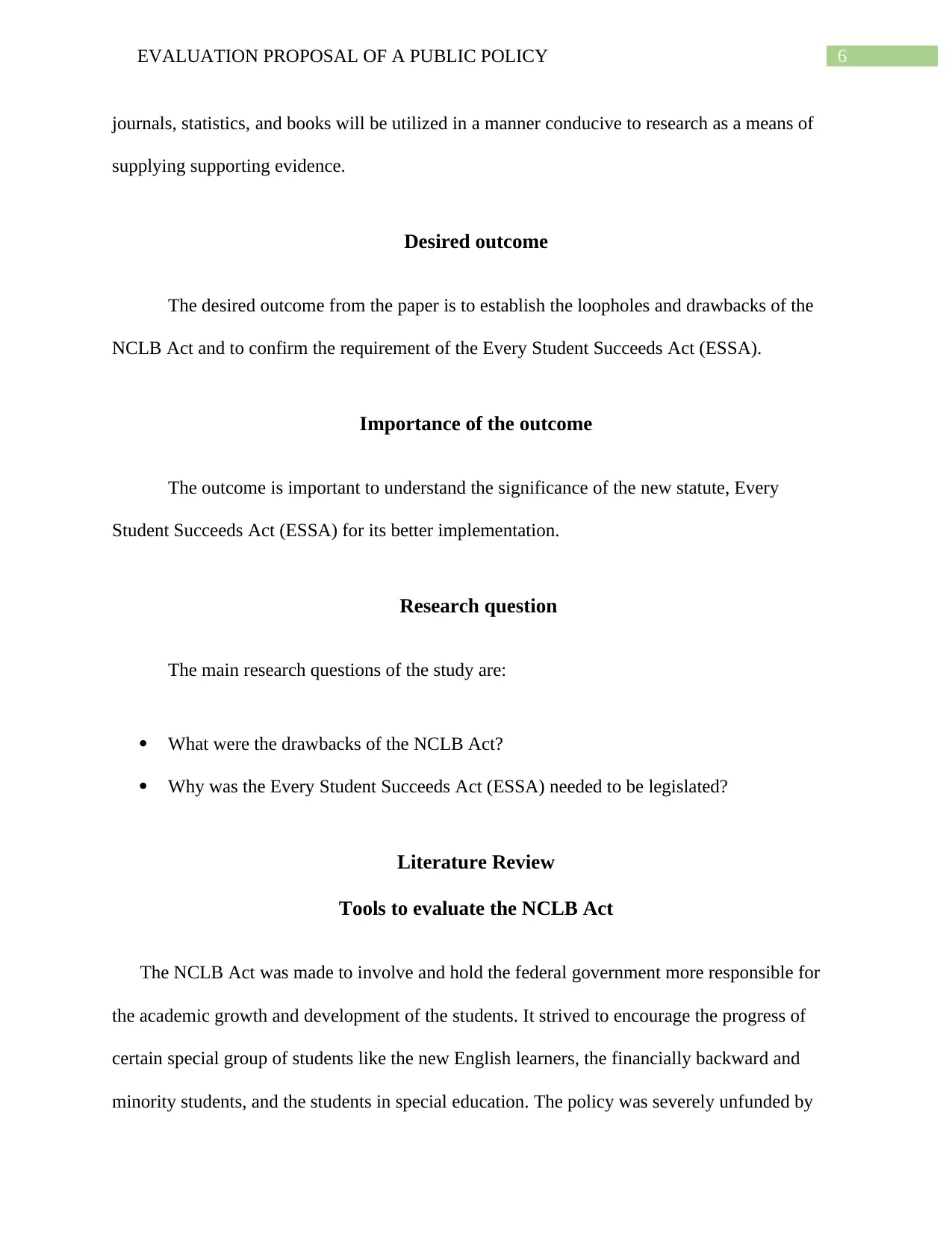
6EVALUATION PROPOSAL OF A PUBLIC POLICY
journals, statistics, and books will be utilized in a manner conducive to research as a means of
supplying supporting evidence.
Desired outcome
The desired outcome from the paper is to establish the loopholes and drawbacks of the
NCLB Act and to confirm the requirement of the Every Student Succeeds Act (ESSA).
Importance of the outcome
The outcome is important to understand the significance of the new statute, Every
Student Succeeds Act (ESSA) for its better implementation.
Research question
The main research questions of the study are:
What were the drawbacks of the NCLB Act?
Why was the Every Student Succeeds Act (ESSA) needed to be legislated?
Literature Review
Tools to evaluate the NCLB Act
The NCLB Act was made to involve and hold the federal government more responsible for
the academic growth and development of the students. It strived to encourage the progress of
certain special group of students like the new English learners, the financially backward and
minority students, and the students in special education. The policy was severely unfunded by
journals, statistics, and books will be utilized in a manner conducive to research as a means of
supplying supporting evidence.
Desired outcome
The desired outcome from the paper is to establish the loopholes and drawbacks of the
NCLB Act and to confirm the requirement of the Every Student Succeeds Act (ESSA).
Importance of the outcome
The outcome is important to understand the significance of the new statute, Every
Student Succeeds Act (ESSA) for its better implementation.
Research question
The main research questions of the study are:
What were the drawbacks of the NCLB Act?
Why was the Every Student Succeeds Act (ESSA) needed to be legislated?
Literature Review
Tools to evaluate the NCLB Act
The NCLB Act was made to involve and hold the federal government more responsible for
the academic growth and development of the students. It strived to encourage the progress of
certain special group of students like the new English learners, the financially backward and
minority students, and the students in special education. The policy was severely unfunded by
Paraphrase This Document
Need a fresh take? Get an instant paraphrase of this document with our AI Paraphraser
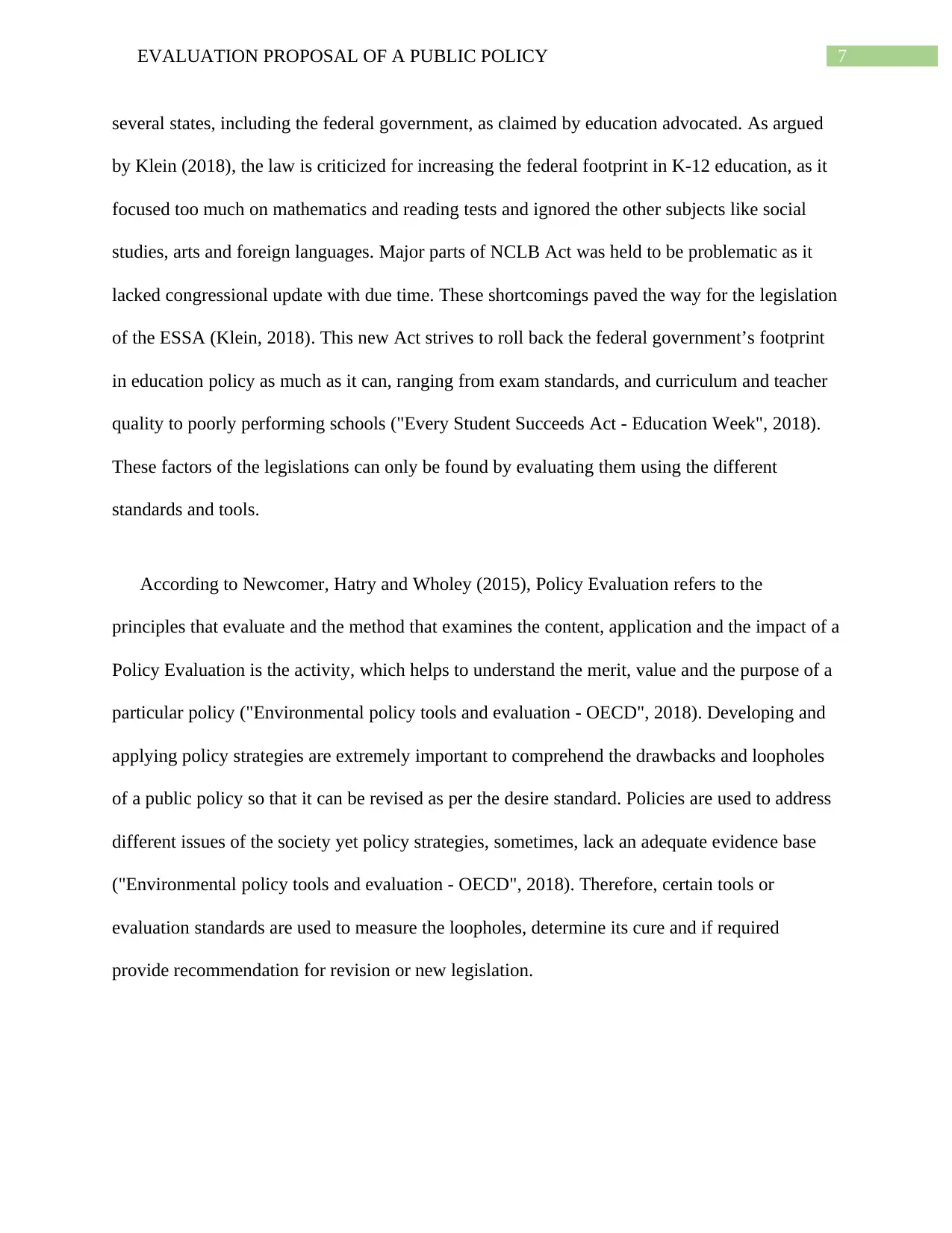
7EVALUATION PROPOSAL OF A PUBLIC POLICY
several states, including the federal government, as claimed by education advocated. As argued
by Klein (2018), the law is criticized for increasing the federal footprint in K-12 education, as it
focused too much on mathematics and reading tests and ignored the other subjects like social
studies, arts and foreign languages. Major parts of NCLB Act was held to be problematic as it
lacked congressional update with due time. These shortcomings paved the way for the legislation
of the ESSA (Klein, 2018). This new Act strives to roll back the federal government’s footprint
in education policy as much as it can, ranging from exam standards, and curriculum and teacher
quality to poorly performing schools ("Every Student Succeeds Act - Education Week", 2018).
These factors of the legislations can only be found by evaluating them using the different
standards and tools.
According to Newcomer, Hatry and Wholey (2015), Policy Evaluation refers to the
principles that evaluate and the method that examines the content, application and the impact of a
Policy Evaluation is the activity, which helps to understand the merit, value and the purpose of a
particular policy ("Environmental policy tools and evaluation - OECD", 2018). Developing and
applying policy strategies are extremely important to comprehend the drawbacks and loopholes
of a public policy so that it can be revised as per the desire standard. Policies are used to address
different issues of the society yet policy strategies, sometimes, lack an adequate evidence base
("Environmental policy tools and evaluation - OECD", 2018). Therefore, certain tools or
evaluation standards are used to measure the loopholes, determine its cure and if required
provide recommendation for revision or new legislation.
several states, including the federal government, as claimed by education advocated. As argued
by Klein (2018), the law is criticized for increasing the federal footprint in K-12 education, as it
focused too much on mathematics and reading tests and ignored the other subjects like social
studies, arts and foreign languages. Major parts of NCLB Act was held to be problematic as it
lacked congressional update with due time. These shortcomings paved the way for the legislation
of the ESSA (Klein, 2018). This new Act strives to roll back the federal government’s footprint
in education policy as much as it can, ranging from exam standards, and curriculum and teacher
quality to poorly performing schools ("Every Student Succeeds Act - Education Week", 2018).
These factors of the legislations can only be found by evaluating them using the different
standards and tools.
According to Newcomer, Hatry and Wholey (2015), Policy Evaluation refers to the
principles that evaluate and the method that examines the content, application and the impact of a
Policy Evaluation is the activity, which helps to understand the merit, value and the purpose of a
particular policy ("Environmental policy tools and evaluation - OECD", 2018). Developing and
applying policy strategies are extremely important to comprehend the drawbacks and loopholes
of a public policy so that it can be revised as per the desire standard. Policies are used to address
different issues of the society yet policy strategies, sometimes, lack an adequate evidence base
("Environmental policy tools and evaluation - OECD", 2018). Therefore, certain tools or
evaluation standards are used to measure the loopholes, determine its cure and if required
provide recommendation for revision or new legislation.

8EVALUATION PROPOSAL OF A PUBLIC POLICY
What were the drawbacks of the NCLB Act?
The drawbacks of the No Child left Behind (NCLB) Act are to be determined through the
following categories of tools and standards for carrying out the evaluation process ("Step by
Step – Evaluating Violence and Injury Prevention Policies", 2018).
Performance Measurement by engaging stakeholders
The tool of performance management helps to determine the rate of performance
of the Statute or public policy in this regard. By the word ‘performance’ the functionality
of the policy is mostly taken into consideration. The performance of the policy is
determined by the feedbacks that are collected from the stakeholders, that is, the group of
people for whom the policy was framed. Therefore, Kitchen and Berk, (2016) held that
the people who are directly governed by the policy must be engaged and taken feedbacks
from, regarding the functionality of the policy. They are the people to comment, as they
are the ones who are affected because of its loopholes and shortcomings.
Utility of the Act
The utility of the policy is to be determined by the statistical values and the again
from the feedback of the people for whom the policy has been made. The statistical
changes that are calculated by the economists and political scientists form the major view
whether the particular policy has a utility and whether it is serving its purpose well. The
statistical data would give a clear picture of it. The Act did not serve its purpose clearly
and for that, it was replaced with the Every Student Succeeds Act (ESSA).
Feasibility
What were the drawbacks of the NCLB Act?
The drawbacks of the No Child left Behind (NCLB) Act are to be determined through the
following categories of tools and standards for carrying out the evaluation process ("Step by
Step – Evaluating Violence and Injury Prevention Policies", 2018).
Performance Measurement by engaging stakeholders
The tool of performance management helps to determine the rate of performance
of the Statute or public policy in this regard. By the word ‘performance’ the functionality
of the policy is mostly taken into consideration. The performance of the policy is
determined by the feedbacks that are collected from the stakeholders, that is, the group of
people for whom the policy was framed. Therefore, Kitchen and Berk, (2016) held that
the people who are directly governed by the policy must be engaged and taken feedbacks
from, regarding the functionality of the policy. They are the people to comment, as they
are the ones who are affected because of its loopholes and shortcomings.
Utility of the Act
The utility of the policy is to be determined by the statistical values and the again
from the feedback of the people for whom the policy has been made. The statistical
changes that are calculated by the economists and political scientists form the major view
whether the particular policy has a utility and whether it is serving its purpose well. The
statistical data would give a clear picture of it. The Act did not serve its purpose clearly
and for that, it was replaced with the Every Student Succeeds Act (ESSA).
Feasibility
⊘ This is a preview!⊘
Do you want full access?
Subscribe today to unlock all pages.

Trusted by 1+ million students worldwide
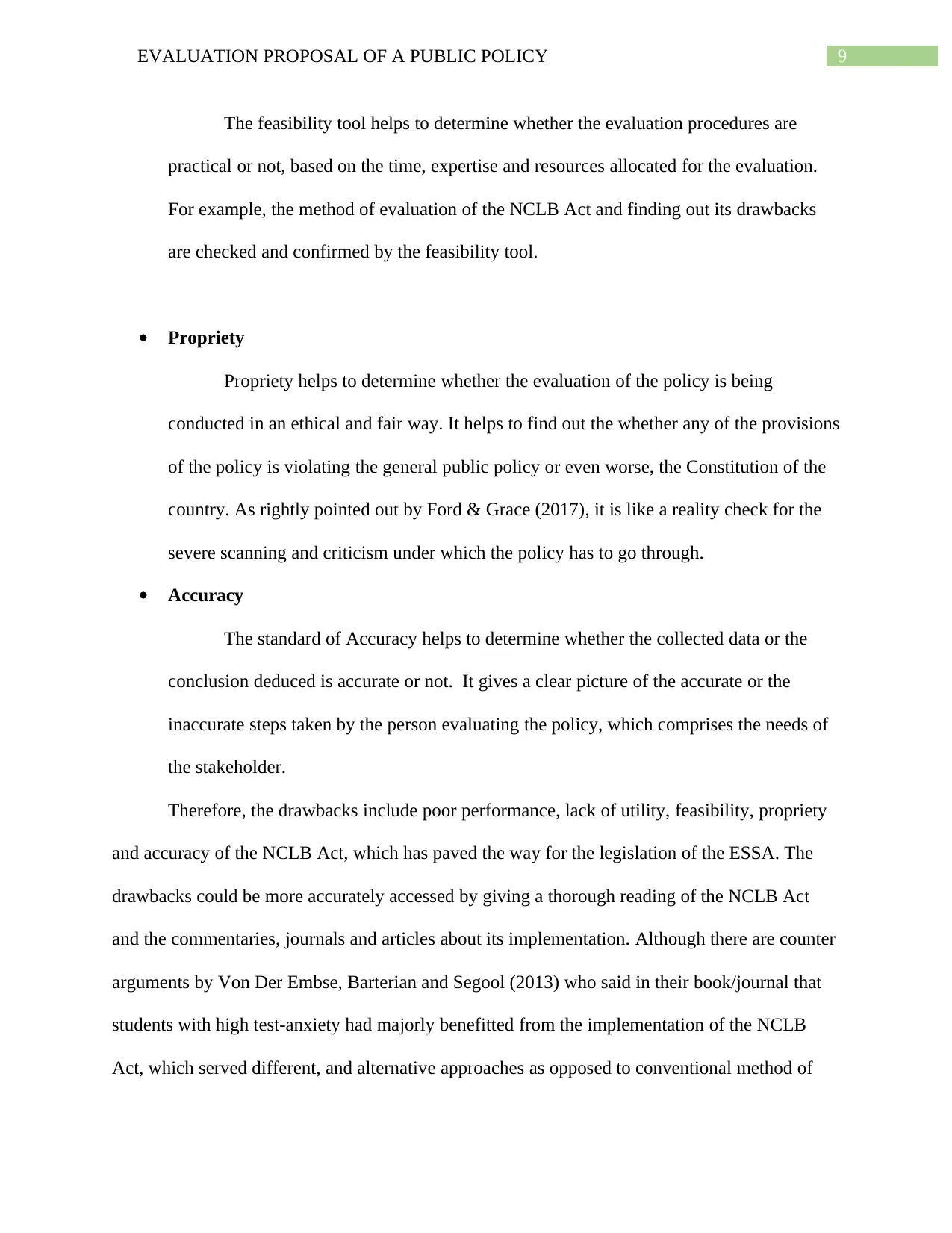
9EVALUATION PROPOSAL OF A PUBLIC POLICY
The feasibility tool helps to determine whether the evaluation procedures are
practical or not, based on the time, expertise and resources allocated for the evaluation.
For example, the method of evaluation of the NCLB Act and finding out its drawbacks
are checked and confirmed by the feasibility tool.
Propriety
Propriety helps to determine whether the evaluation of the policy is being
conducted in an ethical and fair way. It helps to find out the whether any of the provisions
of the policy is violating the general public policy or even worse, the Constitution of the
country. As rightly pointed out by Ford & Grace (2017), it is like a reality check for the
severe scanning and criticism under which the policy has to go through.
Accuracy
The standard of Accuracy helps to determine whether the collected data or the
conclusion deduced is accurate or not. It gives a clear picture of the accurate or the
inaccurate steps taken by the person evaluating the policy, which comprises the needs of
the stakeholder.
Therefore, the drawbacks include poor performance, lack of utility, feasibility, propriety
and accuracy of the NCLB Act, which has paved the way for the legislation of the ESSA. The
drawbacks could be more accurately accessed by giving a thorough reading of the NCLB Act
and the commentaries, journals and articles about its implementation. Although there are counter
arguments by Von Der Embse, Barterian and Segool (2013) who said in their book/journal that
students with high test-anxiety had majorly benefitted from the implementation of the NCLB
Act, which served different, and alternative approaches as opposed to conventional method of
The feasibility tool helps to determine whether the evaluation procedures are
practical or not, based on the time, expertise and resources allocated for the evaluation.
For example, the method of evaluation of the NCLB Act and finding out its drawbacks
are checked and confirmed by the feasibility tool.
Propriety
Propriety helps to determine whether the evaluation of the policy is being
conducted in an ethical and fair way. It helps to find out the whether any of the provisions
of the policy is violating the general public policy or even worse, the Constitution of the
country. As rightly pointed out by Ford & Grace (2017), it is like a reality check for the
severe scanning and criticism under which the policy has to go through.
Accuracy
The standard of Accuracy helps to determine whether the collected data or the
conclusion deduced is accurate or not. It gives a clear picture of the accurate or the
inaccurate steps taken by the person evaluating the policy, which comprises the needs of
the stakeholder.
Therefore, the drawbacks include poor performance, lack of utility, feasibility, propriety
and accuracy of the NCLB Act, which has paved the way for the legislation of the ESSA. The
drawbacks could be more accurately accessed by giving a thorough reading of the NCLB Act
and the commentaries, journals and articles about its implementation. Although there are counter
arguments by Von Der Embse, Barterian and Segool (2013) who said in their book/journal that
students with high test-anxiety had majorly benefitted from the implementation of the NCLB
Act, which served different, and alternative approaches as opposed to conventional method of
Paraphrase This Document
Need a fresh take? Get an instant paraphrase of this document with our AI Paraphraser

10EVALUATION PROPOSAL OF A PUBLIC POLICY
evaluating students on the basis of tests. Therapeutic approaches like biofeedback, priming
competency, behaviour therapy, et cetera helped the students to improve.
Why was Every Student Succeeds Act (ESSA) needed to be legislated?
The failure of the NCLB Act has paved the way for the legislation of ESSA. To evaluate
the failure of NCLB Act and the implementation of the ESSA the following tools and standards
are used:
Evaluating the content of the policy
The content of the previous policy that has been replaced is initially evaluated and
on finding the shortcomings, a newer legislation is drafted. The new legislation needs
evaluation as well for its better understanding and interpretation.
Evaluating the implementation of the policy
The new and old policy needs to be evaluated based on its implementation. It
needs to be found out the reason as to why the old Act did not work. The shortcomings
and the challenges of the implementation of the previous policy needs to be analyzed so
that the need for the new legislation can be supported. The implementation and the
effectiveness of the new policy needs evaluation to find out whether it would serve the
purpose for which it was framed (McGuinn, 2016).
Evaluating the impact of the policy
The impact of a legislation on the society and its stakeholders is its most
significant phenomenon (Reed & Albakry, 2017). The impact of the NCLB Act on its
targeted population was most definitely evaluated and on finding severe drawbacks, it
was replaced by the ESSA. Presently, the impact and significance of ESSA needs
evaluating students on the basis of tests. Therapeutic approaches like biofeedback, priming
competency, behaviour therapy, et cetera helped the students to improve.
Why was Every Student Succeeds Act (ESSA) needed to be legislated?
The failure of the NCLB Act has paved the way for the legislation of ESSA. To evaluate
the failure of NCLB Act and the implementation of the ESSA the following tools and standards
are used:
Evaluating the content of the policy
The content of the previous policy that has been replaced is initially evaluated and
on finding the shortcomings, a newer legislation is drafted. The new legislation needs
evaluation as well for its better understanding and interpretation.
Evaluating the implementation of the policy
The new and old policy needs to be evaluated based on its implementation. It
needs to be found out the reason as to why the old Act did not work. The shortcomings
and the challenges of the implementation of the previous policy needs to be analyzed so
that the need for the new legislation can be supported. The implementation and the
effectiveness of the new policy needs evaluation to find out whether it would serve the
purpose for which it was framed (McGuinn, 2016).
Evaluating the impact of the policy
The impact of a legislation on the society and its stakeholders is its most
significant phenomenon (Reed & Albakry, 2017). The impact of the NCLB Act on its
targeted population was most definitely evaluated and on finding severe drawbacks, it
was replaced by the ESSA. Presently, the impact and significance of ESSA needs
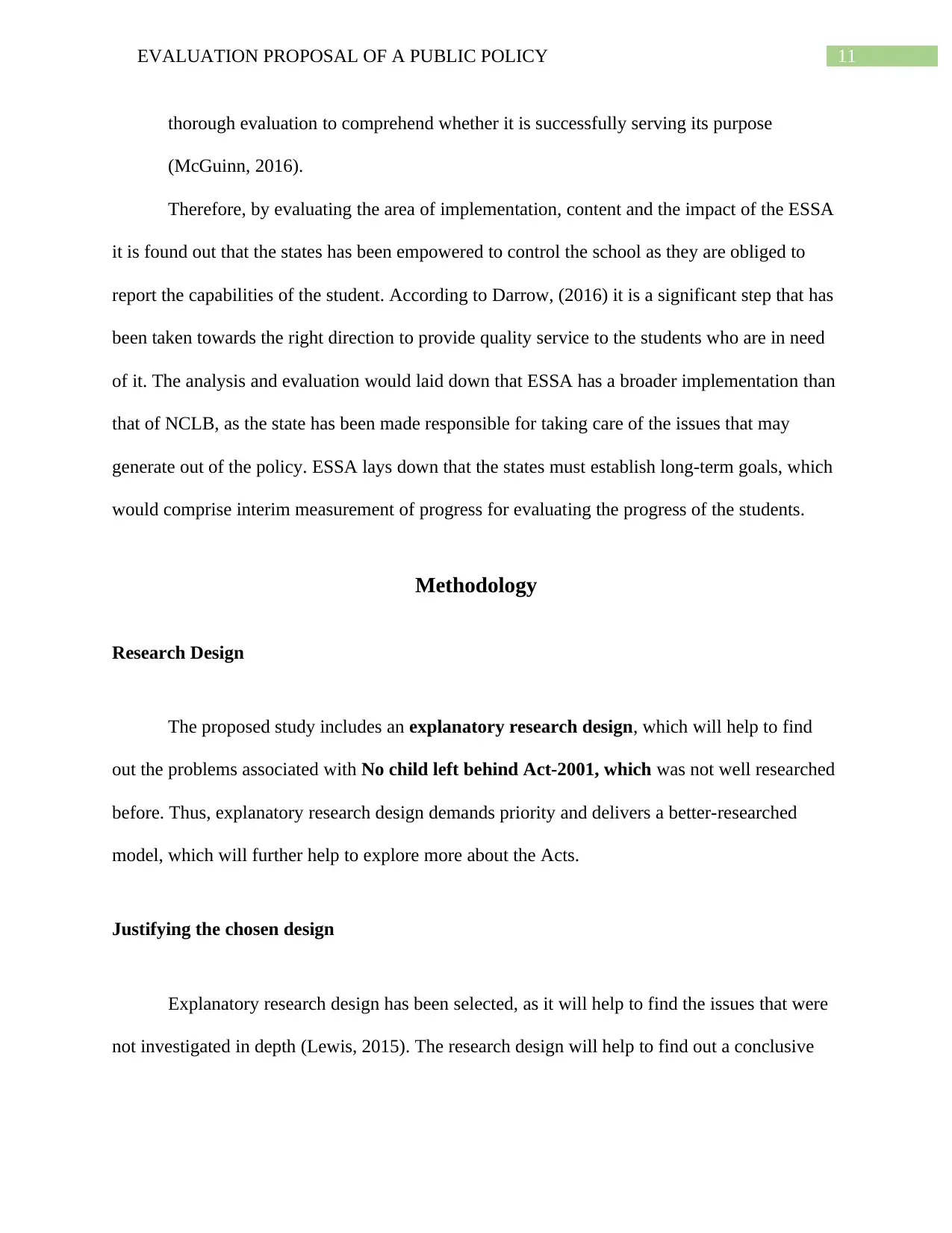
11EVALUATION PROPOSAL OF A PUBLIC POLICY
thorough evaluation to comprehend whether it is successfully serving its purpose
(McGuinn, 2016).
Therefore, by evaluating the area of implementation, content and the impact of the ESSA
it is found out that the states has been empowered to control the school as they are obliged to
report the capabilities of the student. According to Darrow, (2016) it is a significant step that has
been taken towards the right direction to provide quality service to the students who are in need
of it. The analysis and evaluation would laid down that ESSA has a broader implementation than
that of NCLB, as the state has been made responsible for taking care of the issues that may
generate out of the policy. ESSA lays down that the states must establish long-term goals, which
would comprise interim measurement of progress for evaluating the progress of the students.
Methodology
Research Design
The proposed study includes an explanatory research design, which will help to find
out the problems associated with No child left behind Act-2001, which was not well researched
before. Thus, explanatory research design demands priority and delivers a better-researched
model, which will further help to explore more about the Acts.
Justifying the chosen design
Explanatory research design has been selected, as it will help to find the issues that were
not investigated in depth (Lewis, 2015). The research design will help to find out a conclusive
thorough evaluation to comprehend whether it is successfully serving its purpose
(McGuinn, 2016).
Therefore, by evaluating the area of implementation, content and the impact of the ESSA
it is found out that the states has been empowered to control the school as they are obliged to
report the capabilities of the student. According to Darrow, (2016) it is a significant step that has
been taken towards the right direction to provide quality service to the students who are in need
of it. The analysis and evaluation would laid down that ESSA has a broader implementation than
that of NCLB, as the state has been made responsible for taking care of the issues that may
generate out of the policy. ESSA lays down that the states must establish long-term goals, which
would comprise interim measurement of progress for evaluating the progress of the students.
Methodology
Research Design
The proposed study includes an explanatory research design, which will help to find
out the problems associated with No child left behind Act-2001, which was not well researched
before. Thus, explanatory research design demands priority and delivers a better-researched
model, which will further help to explore more about the Acts.
Justifying the chosen design
Explanatory research design has been selected, as it will help to find the issues that were
not investigated in depth (Lewis, 2015). The research design will help to find out a conclusive
⊘ This is a preview!⊘
Do you want full access?
Subscribe today to unlock all pages.

Trusted by 1+ million students worldwide
1 out of 19
Related Documents
Your All-in-One AI-Powered Toolkit for Academic Success.
+13062052269
info@desklib.com
Available 24*7 on WhatsApp / Email
![[object Object]](/_next/static/media/star-bottom.7253800d.svg)
Unlock your academic potential
Copyright © 2020–2025 A2Z Services. All Rights Reserved. Developed and managed by ZUCOL.




